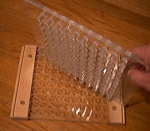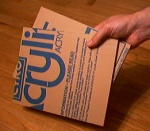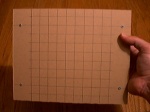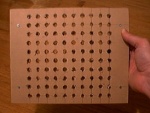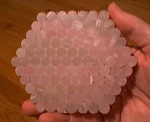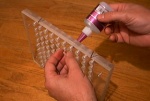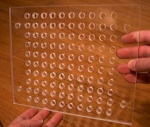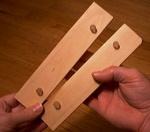Star plate
From PyroGuide
Star plates are used to make large amounts of cylindrical stars. Each set of plates consists of a bottom plate (female) and a top plate (male). To use star plates, you set the female plate on a smooth, flat surface. Then fill the holes in the bottom plate with damp star composition. Then, lower the heavier male plate onto the bottom plate, pressing and compacting the star composition down. Generally, a side to side rocking motion works best. Then, keeping both plates together, gently raise the two up, and press the top plate down so that the stars are gently ejected out.
[edit] MaterialsPlexiglass Sheets Plexiglass Rods Tools |
[edit] ConstructionShown in this picture are two pieces of the paper faced plexiglass sheets which have been cut to identical 8 1/8 by 10 1/8 inch rectangles. One side of the protective paper facing has printed lettering and the other side is blank. The facing is removed from one side of each sheet and the two exposed surfaces are placed against each other for fastening together. |
|
The two plates are securely fastened together with four small wood screws. This is done by drilling holes through the plates which are just slightly smaller than the screws. When screwed in, the screws will cut their own threads without requiring great effort or cracking the plexi. Next, the hole layout is drawn on the blank paper facing as shown. This is a 10 by 10 matrix of holes with 3/8 inch spacing between them. There will be a 1/2 inch border on the top and bottom and a 1 1/2 inch border on the sides. |
|
You will have to use a drill press to drill all the holes through the two plates. Before drilling, a little experimentation will greatly enhance the likelihood that the pins will not bind in the hole plate. Using scrap pieces of plate material, drill a hole through two layers which are securely fastened together. Now check the fit of your pin material in the hole. I found that a 3/8 inch bit actually drilled a hole slightly larger than the desired 3/8 inch, probably due to asymmetries in the drill press chuck. The result is a loose fit of the pin in the pin plate hole. You may need to experiment with a bit that is 1/64 inch (or more) smaller until a snug, but not tight fit is achieved. The holes are drilled at the intersections of the layout marks. It might save you some time centring the intersections under the drill bit if you use a movable guide rail on the drill press deck. Here's a reminder of one of the critical tips mentioned in the Svenson article. Drill every hole with the plate assembly in the same orientation on the drill press deck. Drill the holes slowly, with light pressure, especially as the bit is about the exit from the bottom of the two sheets. The friction heat will soften the plastic and lessen the likelihood of chipping as the bit exits from the material. |
|
Now, the remainder of your day is required to cut approximately 110 pin pieces from the plexiglass rounds. Using a radial arm saw with a stop block will assure that each pin is exactly the same length which, in this case, is 7/8 inches. The ends of the pins are cleaned up by standing them all up on their ends on a flat surface. Tape or a rubber band is wrapped around the bundle of pins to gang them all together in a bunch that is approximately round. Now a vibrator sander is used to sand off the saw blade marks. Doing this on both ends of the pins, you should end up with a bundle that looks something like this picture. If ganging them all up in one bundle is too taxing on your patience, try smaller bundles of 10 to 20. |
|
The original bottom plate, from which the drill bit exited during the drilling step, is designated the pin plate because it is most likely to have a few chip damaged holes in it. There are several possible approaches to gluing the pins in the pin plate. If you have the guts to try it, you can use the method illustrated in the picture. Using medium viscosity cyanoacrylate glue, a meager dab is applied inside the pin plate hole. The pin is pushed through the still attached hole plate until it is flush with the surface of the pin plate. The pin is gently rotated to evenly distribute the glue before it sets in about 10 to 15 seconds. Because the glue is more viscous than the fast setting variety, it will not wick up the pin and weld the pin into the hole plate. This disaster is still a real possibility if you loose your concentration and apply too much glue or place it too far into the hole. The advantage of this method is that the pins are held into alignment by the hole plate. However, if you are not willing to take the risk of gluing the two plates together, separate them and do the gluing with a greater measure of peace of mind. Just remember to keep track of the original orientation of the two plates when the holes were drilled. The pins must be glued in so that when the pin plate is pushed into the hole plate, the two plates will mate in this original orientation. This is critical! You should have about 10 extra pins in case some of them are too tight or too loose. Since they are extruded, their diameter tolerance is fairly loose. Always check the fit before glue is applied. |
|
If you didn't remove the fastening screws and separate the plates in the last step, now is the time to do so. The final phase of tedium is the enlarging of the holes in the hole plate. This step is highly dependent on the success of the previous steps. Ideally, if all the pins are perfectly aligned, the holes won't need enlarging at all. In reality, this seldom happens, and the two plates will stick a little or a lot when trying to mate them together. This is addressed by enlarging all the holes in 1/64 inch increments. Thus, the first enlargement is attempted with a drill bit that is 1/64 inch larger than the one used to drill the original holes. Each hole should be enlarged with the larger bit centred over the original hole. If this hole enlargement is successful, the pin plate should fit into the hole plate without binding or requiring a great deal of effort. Removal should also be fairly smooth. Four stand holes are also drilled in the hole plate where the original holes for the attachment screws are located. These holes are drilled with the same bit that is used for the enlarging.
|
|
A simple stand must be made for the plates. Simply cut two identical blocks of wood to your liking. The stand in the photo was made from scarp 3/4 pine. One of them is taped in place under the wide border portion on each end of the hole plate. The stand holes you drilled earlier are now used as guides to drill a 3/8 hole in two places in each stand block. Using some of your extra plexiglass pins, glue or tap in 4 of them into the holes in the stand blocks. Finally, mark all your starplate tooling in some way to make the right orientation easy to recognize. [edit] References
|
